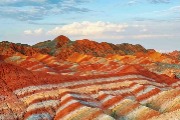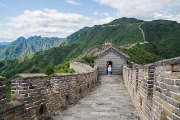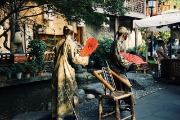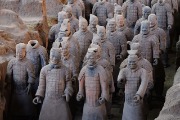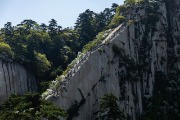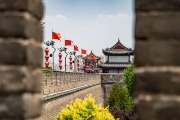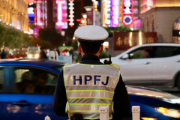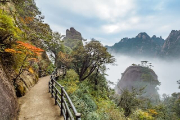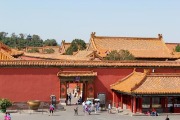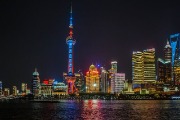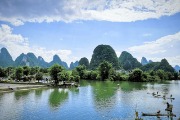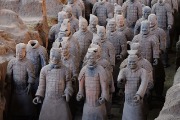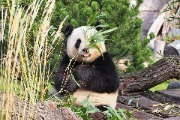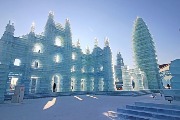Mount Hua in China
Climbing Huashan Mountain takes at least 6 hours to reach the top, and it requires a lot of strength and courage.
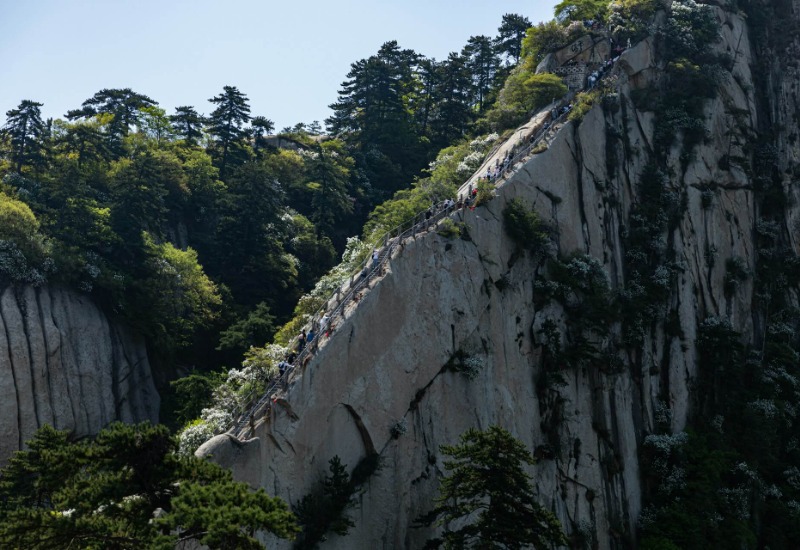
Don’t rush into climbing Mount Hua China (华山) (also called Huashan Mountain) unless you’re really ready for it. The mountain has five peaks, and the paths between them are super steep. Some sections are almost vertical, and you’ll have to climb using just your hands. We’ll tell you all about the thrills of climbing, the five peaks, and how to explore. At the end, we’ll also include some Q&A and ticket info.
Table of Contents
The Five Main Peaks of Mount Hua
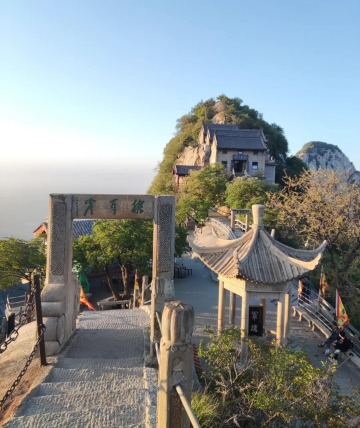
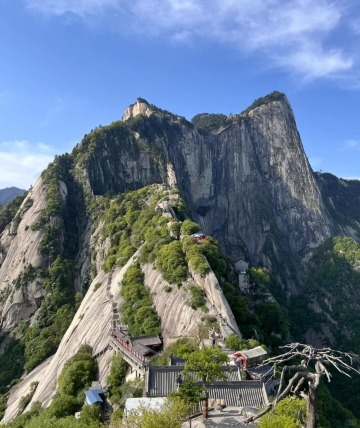
North Peak (Lowest Elevation, with Cable Car) (北峰)
The North Peak is the first peak you’ll reach by taking the North Peak cable car, and it’s also the lowest of the five peaks. Standing at 1,614 meters (about 5,295 feet), it’s much more gentle than the others, making it ideal for hiking. However, the climb still involves some steep cliffside sections. The rocks are tough, and many areas don’t have clear footholds, so you’ll need to climb with both your hands and feet. It requires a lot of patience, determination, and focus. A single mistake could lead to an accident.
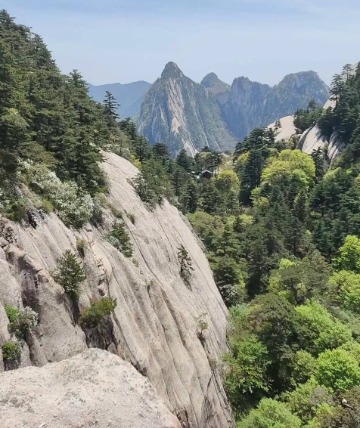
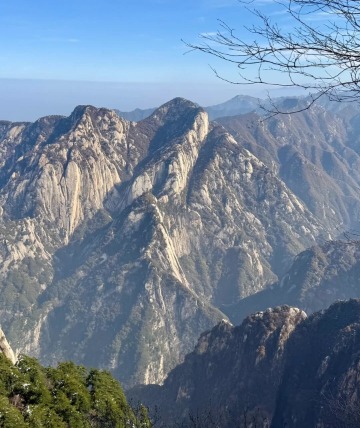
Central Peak (中峰)
After North Peak, the next stop is Central Peak. This peak is actually a small one attached to the west side of East Peak, so it’s easy to overlook. The area is lush with trees, and there’s a refreshing mountain spring flowing nearby. If you’re feeling tired from the hike, it’s a great spot to rest and take in the beautiful scenery around you.
Central Peak is famous for an ancient love story that took place here. The story dates back to the Spring and Autumn period (770–476 BC) in China. A king’s daughter, named Nongyu, passed through this area while a Taoist priest, Xiao Shi, was playing the flute. Nongyu was drawn to the sound of the music. Over time, the two met and fell in love. Nongyu gave up her noble life to live with Xiao Shi in seclusion on Mount Hua, living like an ordinary person. To honor their true love, people later built several monuments on Central Peak to commemorate their story.
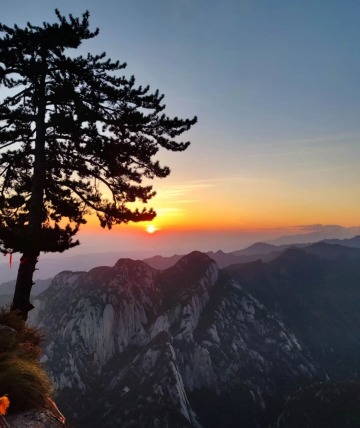
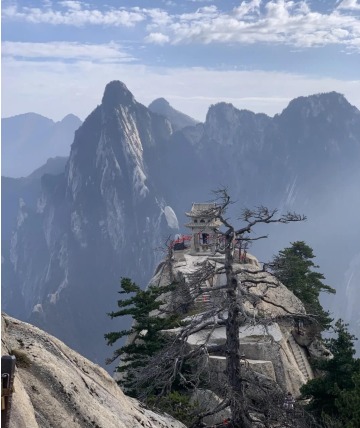
East Peak (Best Spot to Watch the Sunrise) (东峰)
After Central Peak, most people choose East Peak as their next stop. East Peak is the best place on Mount Hua China to catch the sunrise. Its viewing platform faces east, offering an open, unobstructed view of the spectacular sunrise. From here, you can also see the surrounding mountains and sea of clouds—it’s truly a breathtaking sight.
The terrain of East Peak is extremely rugged. In ancient times, the path to the top was so difficult that people had to climb steep rocks by hand. Although the trail has now been paved and widened, it’s still very steep. In some areas, there are even staff members stationed to watch over hikers and make sure no one accidentally falls. If that happens, they’re there to catch you!
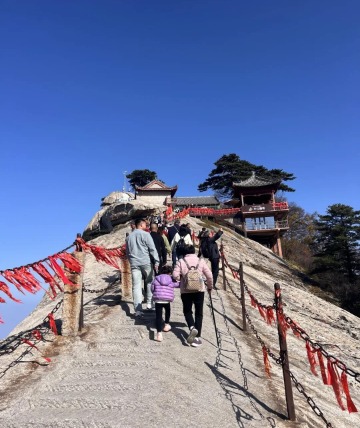
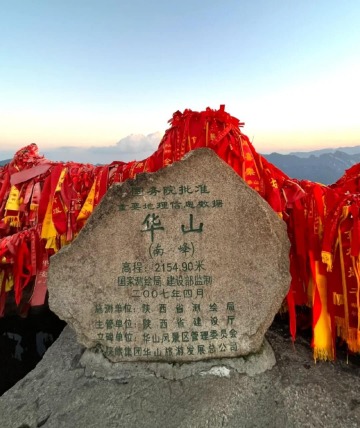
South Peak (Highest Elevation) (南峰)
After enjoying the views from East Peak, the next stop is South Peak. This is the highest peak on Mount Hua, often nicknamed the “Head of Mount Hua.” Many visitors say that once they reach South Peak, they feel as if they’re incredibly close to the sky, almost able to touch the stars above. From the top, you can see the rolling mountains, the majestic Yellow River and Wei River, as well as the vast plains in the distance.
South Peak is also said to be the place where Laozi, the founder of Taoism, once lived in seclusion. Laozi is a highly respected figure in Chinese history. He was a famous philosopher and thinker during the Spring and Autumn period (770–476 BC). Laozi’s ideas had a profound impact on Chinese philosophy. He believed that when things reach their extreme, they begin to turn into their opposites. He also advocated for minimal government intervention, focusing on people’s well-being and being close to the common folk. These teachings continue to be valued by the Chinese to this day.
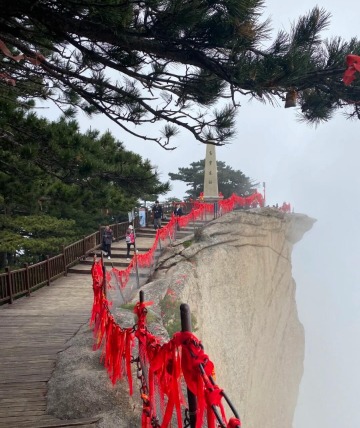
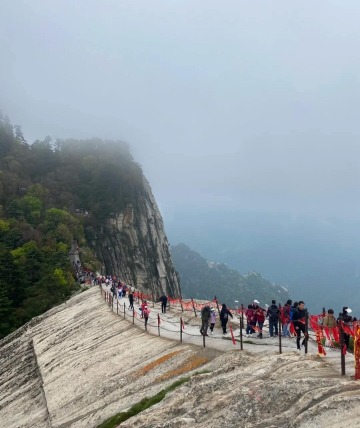
West Peak (Most Beautiful Views, with Cable Car) (西峰)
West Peak is the final stop on Mount Hua China, and it’s where you can take a cable car down the mountain. There’s a famous giant rock here that looks like a lotus flower, which is why West Peak is also called Lotus Peak.
On West Peak, there’s a massive rock that’s split right down the middle, as if it’s been struck by an axe. This is known as “Axe-Cut Rock,” and next to it stands a large axe. The story behind it is linked to a famous Chinese myth, “The Lotus Lantern.” It tells the tale of a boy named Chen Xiang, who, after enduring countless hardships, finally used an axe to split open a mountain and rescue his mother.
Famous Attractions on Mount Hua
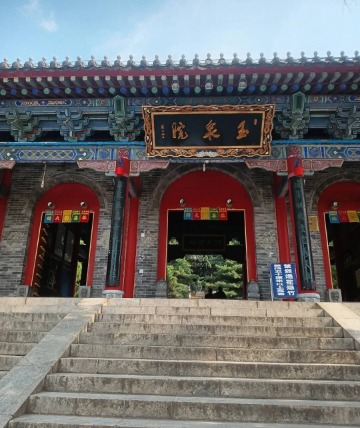
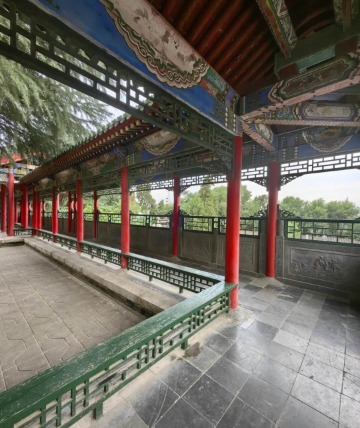
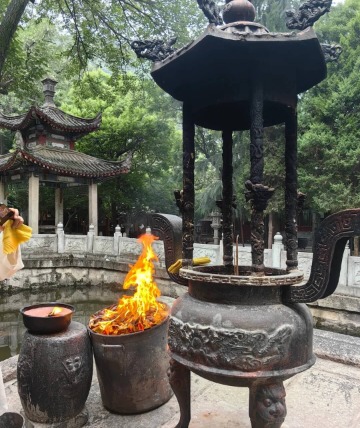

Yuquan Temple (玉泉院)
Yuquan Temple was built during the Song Dynasty (960–1279) and is one of the main Taoist sites on China Mount Hua. It’s also a must-see stop on your hike. Here, you can admire the ancient architectural style and beautiful murals, while experiencing the unique charm of Chinese Taoist culture.
Today, Yuquan Temple has become an important place for studying Taoism. There are many Taoist sects in China, and the one on Mount Huashan China is the Quanzhen School. The Quanzhen philosophy emphasizes the idea of “purity and non-action.” This thought has greatly influenced ancient Chinese scholars, promoting the idea of seeking inner peace and wisdom through tranquility and living in harmony with nature.
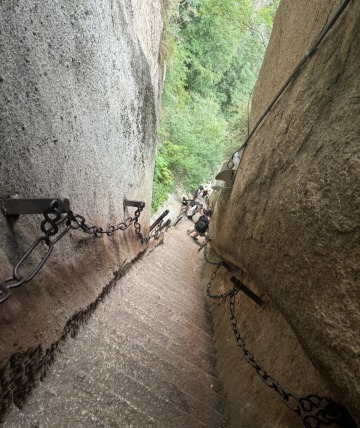
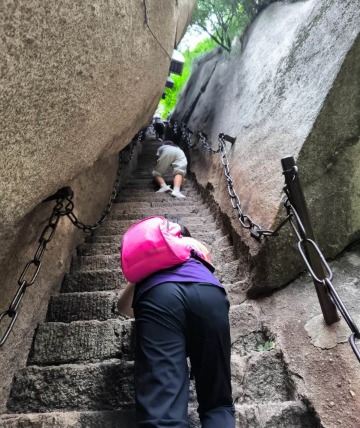
Qianchi Zhuang (千尺幢)
Qianchi Zhuang is located on the east side of South Peak, with a slope close to 70 degrees. It has over 370 steps, each only about a third the width of your foot. As you climb, you’ll follow cracks in the cliff, making the journey extremely thrilling. While it’s a challenging climb, the stunning views along the way and the sense of accomplishment when you reach the top make it all worthwhile.
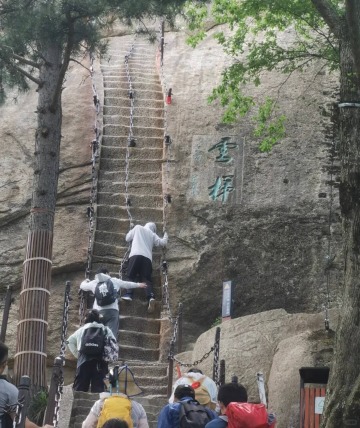
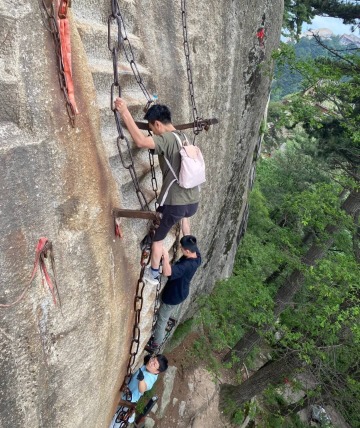
Cloud Ladder (云梯)
The Cloud Ladder is located on the north side of Central Peak, standing over 10 meters tall and forming a nearly vertical 90-degree angle with the ground. To climb it, you’ll need to grip an iron chain, swinging your body as you go, almost as if you’re riding the clouds—hence the name “Cloud Ladder.” This climb requires strong arm strength, as the middle section of the cliff seems to slope beyond 90 degrees, so you’ll rely mostly on your arms to pull yourself up.
Some visitors find the Cloud Ladder short but thrilling. It’s not too difficult to climb, but the psychological pressure can be intense. Others argue that the difficulty is exaggerated and that, in reality, it’s not that hard to climb.
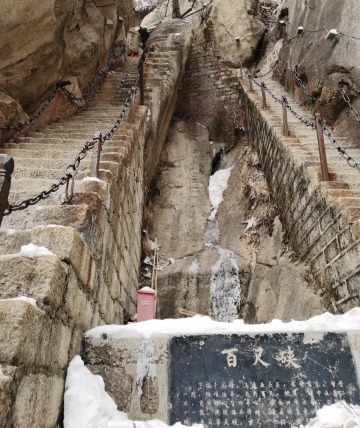
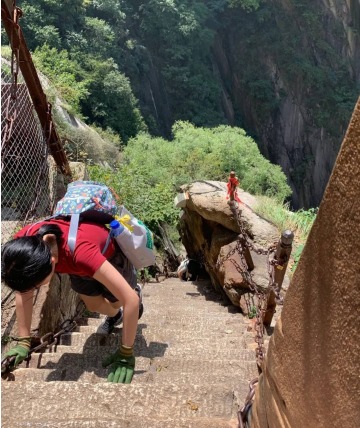
Baichi Gorge (百尺峡)
Baichi Gorge is flanked by sheer cliffs on both sides, with only a narrow stone staircase running through the middle.
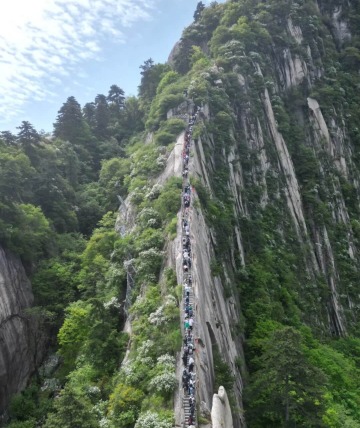
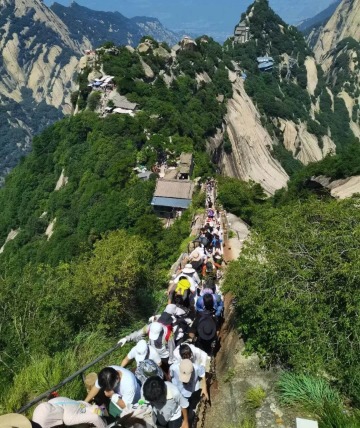
Canglong Ridge (苍龙岭)
Canglong Ridge is located between the North Peak and West Peak of Mount Huashan China, stretching about 100 meters with a slope of over 45°. It’s a very steep section, but the stairs built during the Ming and Qing Dynasties, along with modern safety measures, make the path much safer today. However, it’s important to hold onto the handrails on both sides while walking, as the wind on Mount Hua can be strong, and you might lose your balance.
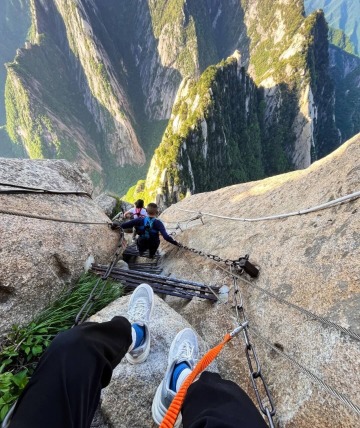
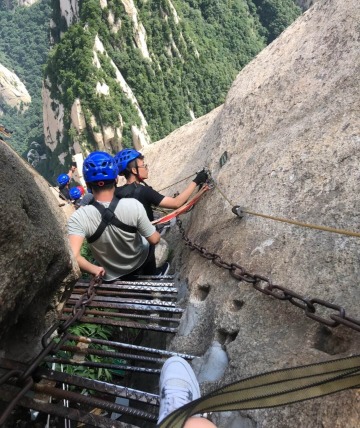
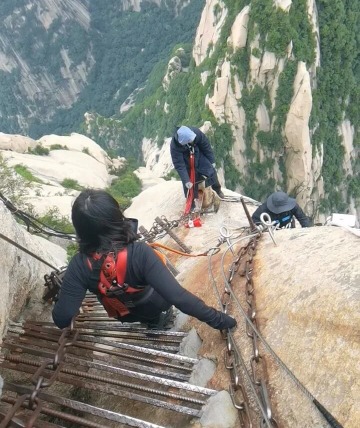
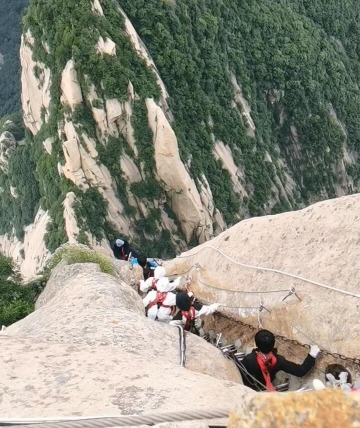
Yaozi Turns (鹞子翻身)
Yaozi Turns Flip is located at the edge of a cliff on East Peak, with a sheer drop below that seems endless. When climbing, you need to stay fully focused—grip tightly, watch your steps, use your knees for support, and make sure each step is secure. During the experience, staff will help visitors put on safety harnesses and explain how to use them, ensuring safety. Even so, for those with a fear of heights, it’s important to proceed with caution.
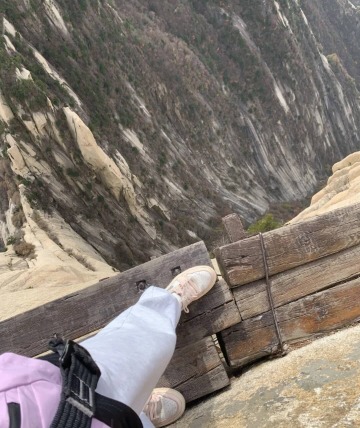

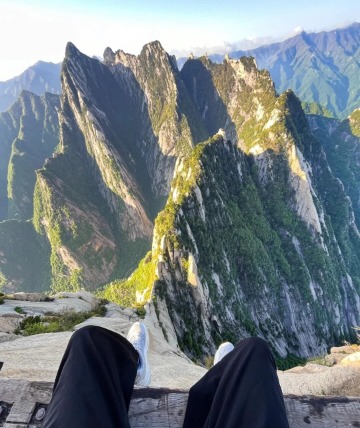
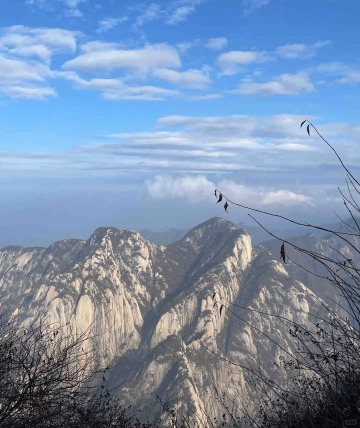
Chang Kong Plank Road (长空栈道)
The Chang Kong Plank Road is located halfway up South Peak, stretching 110 meters in length. The path clings to the cliffside, with an immense abyss below. The road is divided into three sections, each with varying levels of difficulty. The first section is protected by iron railings, making it relatively safer. However, as you continue, the path becomes steeper and more dangerous, requiring you to hold onto iron chains as you descend, almost as if suspended in mid-air. Despite safety measures like harnesses and iron chains, many visitors feel nervous when facing such a daunting view.
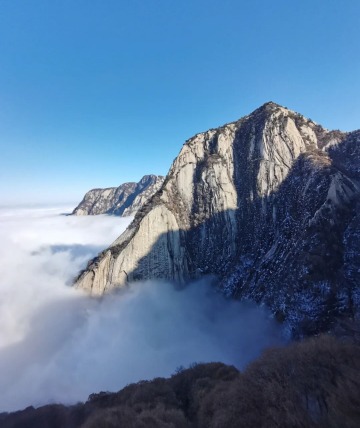
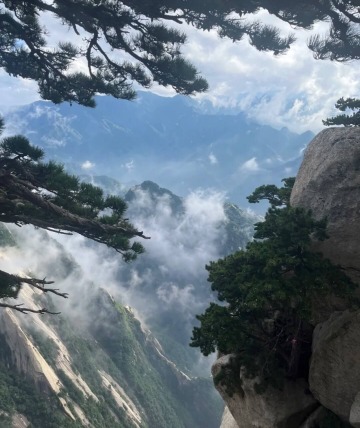
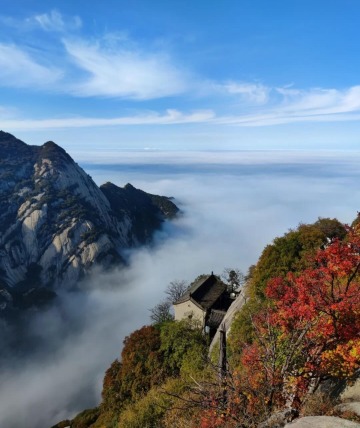
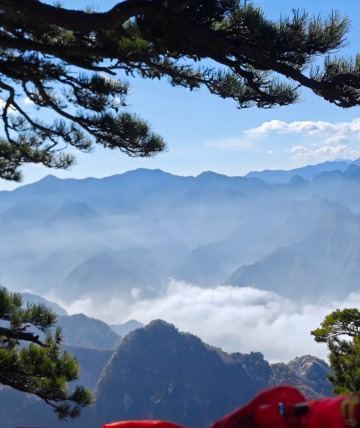
Mount Hua Shan Sea of Clouds (华山云海)
The beauty of Mount Huashan Huayin isn’t just in its steepness, but also in the magnificent views above the sea of clouds. Standing at the top, you’ll see a vast sea of clouds rolling beneath you, making it feel as though you’re standing right in the clouds, instantly lifting your spirits. If you visit on a clear day, you’ll get to see the stunning sea of clouds. Even if it rained the day before, heading out at sunrise the next morning will still offer you a spectacular view of the clouds.
Ways to Explore Huashan Mountain
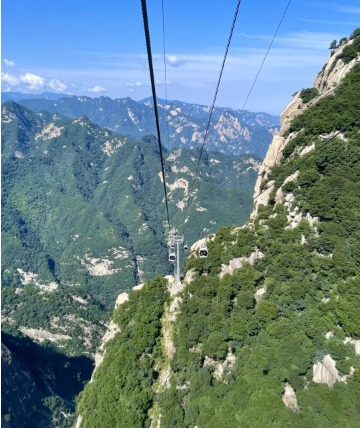

North Peak Cable Car (北峰索道)
Many visitors choose the route of taking the North Peak cable car up and the West Peak cable car down to avoid the crowds at the West Peak. The North Peak cable car is 1,550 meters long, offering a great view of the entire mountain along the way. The one-way ticket costs 80 CNY (about 11 USD), while a round-trip ticket is 150 CNY (about 20 USD). The cable car seats six people per cabin.
The North Peak cable car operates daily from 7:00 AM to 7:00 PM. The latest time to ascend is 4:00 PM, and the latest time to descend is 7:00 PM.
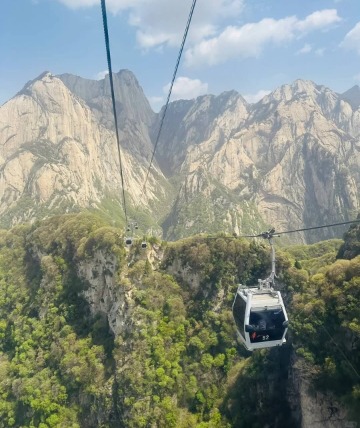
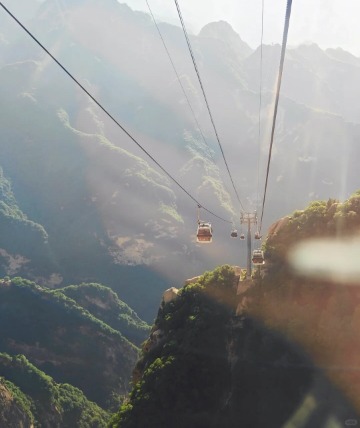
West Peak Cable Cark (西峰索道)
The West Peak cable car spans 4,211 meters and takes just 18 minutes to reach the top. Since many visitors bring elderly people or children who have limited stamina, they often just want to visit the West Peak and leave. As a result, the lines for the West Peak cable car can get very long. Some visitors have reported waiting up to 3 hours just to buy tickets and board the cable car.
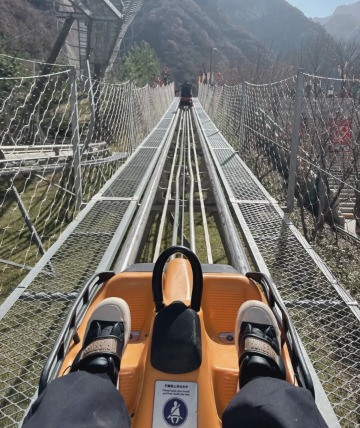
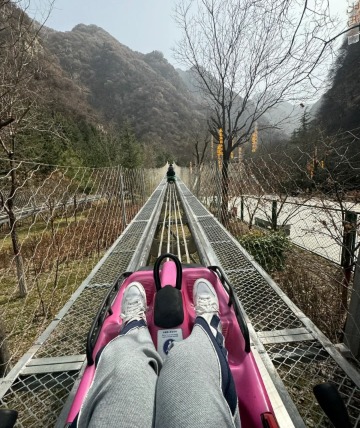
Slide (滑道)
Compared to walking down the mountain, the slide not only saves energy but also provides a more exciting and unique experience. The slide is very thrilling, especially on the descent, giving you a roller-coaster-like feeling.
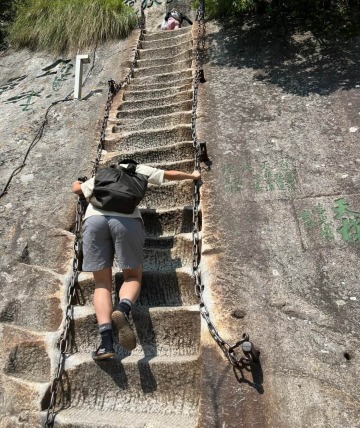
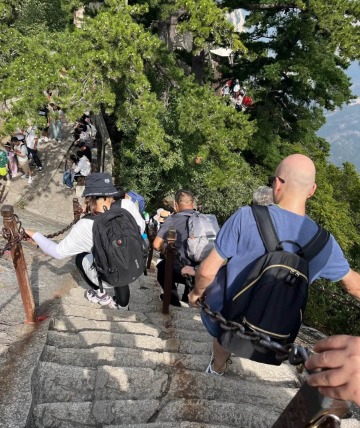
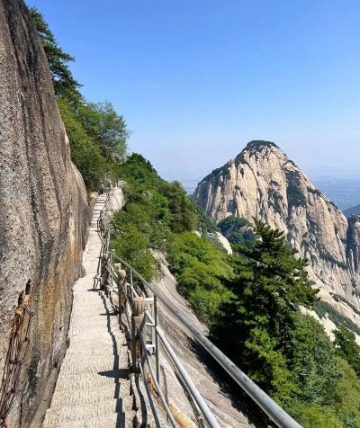

Hiking Mount Hua (徒步华山)
The hiking trails on Mount Huashan Huayin are quite steep, especially in sections like Qianchi Zhuang, Baichi Gorge, and Laojun Li Gou. These areas have very sharp inclines, and you’ll need to hold tightly onto iron chains to pass safely. The entire hike typically takes about 7 to 9 hours, depending on your fitness level and the number of breaks you take.
For those with little outdoor experience, it’s recommended to train your stamina beforehand and bring essential gear such as trekking poles and anti-slip gloves.
Additionally, the weather on China Huashan Mountain can be unpredictable, especially during the climb. It’s a good idea to carry a jacket and rain gear to prepare for sudden rain showers.
Hot Springs Near Mount Huashan
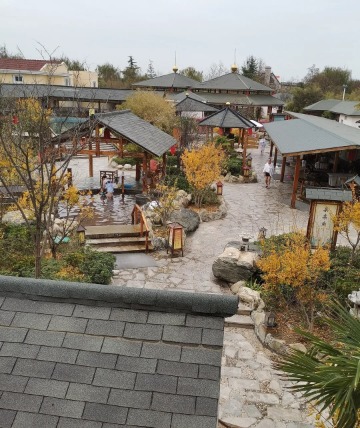

Yu Hot Spring (御温泉)
At the foot of Huashan Mountain, there is a hot spring-themed hotel: Hua Shan Yu Hot Spring Resort.
The hot spring area features a children’s play area, adult slides, and bubble pools, where kids can have a great time. The staff provides excellent service, especially in the children’s area, where they carefully look after the kids to ensure their safety. Additionally, the hot spring area is open until midnight, while the children’s area closes at 6:00 PM, giving plenty of time for families to enjoy the hot springs.
Accommodation on Mount Hua
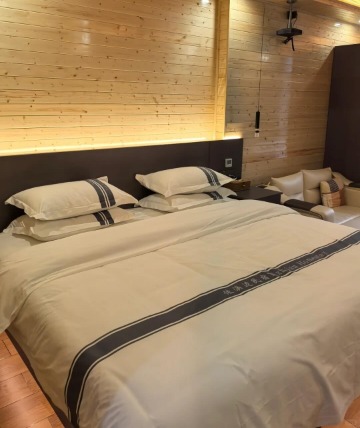

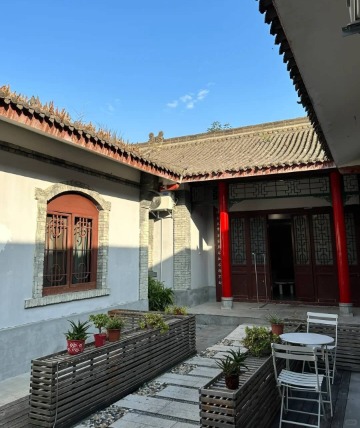
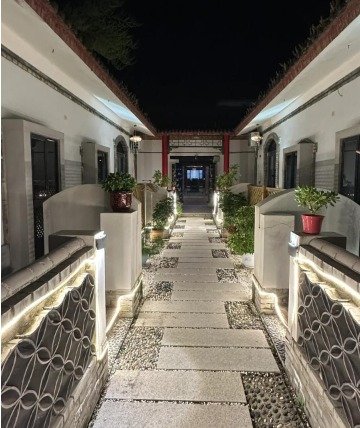
There are accommodations available at the top of Mount Hua, but due to the mountain’s unique location, the facilities are quite basic, usually with shared rooms for multiple people. The rooms typically come with basic beds, tables, chairs, and lighting. Some inns may offer hot water for showers, while others do not.
Therefore, I recommend hiking up the mountain in the morning and descending before dark to stay at a hotel near Mount Hua. Many nearby hotels feature simple, modern decor and excellent service, with some even offering shuttle service to and from the entrance of Mount Hua.
Time Required to Reach Each Peak on Mount Hua
North Peak:
Starting from Yuquan Temple, it takes about 3 hours to hike to North Peak.
Central Peak:
It takes about 1 to 1.5 hours to reach Central Peak. Along the way, you’ll pass scenic spots like Canglong Ridge and Turtle Rock.
East Peak:
It takes around 20 minutes to get from Central Peak to East Peak.
South Peak:
It takes about 1 hour to hike from East Peak to South Peak, and along the way, you’ll pass the thrilling Chang Kong Plank Road.
West Peak:
From South Peak to West Peak, it takes about 30 minutes.
FAQs About Mount Hua
1. Why is Mount Hua so famous?
Mount Hua is famous for its rugged terrain and steep trails, where climbers often need to use both hands and feet, relying on iron chains to scale the cliffs. In addition to its natural beauty, Mount Hua is also one of the birthplaces of Taoism in China. It is one of the earliest “sacred mountains” worshiped in China, believed to be the mountain that governs gold, silver, copper, and iron.
2. Where is Mount Hua?
Mount Hua is located in Huayin City, Shaanxi Province, about 120 kilometers from Xi’an.
3. How long does it take to hike Mount Hua?
The time it takes to hike Mount Hua varies from person to person, but it generally takes around 6 to 8 hours. The exact time depends on your physical fitness and hiking speed.
4. What is the elevation of Mount Hua?
The elevation of Hua Mountain is 2,154.9 meters (about 7,070 feet), which is the highest point of the mountain.
How to Get to Mount Hua Shan
High-Speed Rail:
You can take a high-speed train from Xi’an North Station to Huashan North Station, with a travel time of about 30 minutes and a ticket price of around 54.5 CNY (about 7 USD). Once you arrive at Huashan North Station, you can take the free bus (Route 1 or Route 2) to the Huashan Tourist Center.
Train:
You can take a regular train from Xi’an Railway Station to Huashan Station, which takes about 90 minutes. The ticket price ranges from 18.5 CNY (about 2.5 USD) to 30 CNY (about 4 USD). After arriving at Huashan Station, you can take a taxi or a bus to the scenic area.
Hours & Fees
Hours
Hiking: Open 24 hours
Upward Cable Car: 7:00 AM – 4:00 PM
Downward Cable Car: 7:00 AM – 8:00 PM
Time Required
6-10 hours.
Fees
Ticket Prices:
Peak Season (March 1st to November 30th): 160 CNY (about 22 USD) per person
Off-Season (December 1st to February 28th): 100 CNY (about 13 USD) per person
West Peak Cable Car:
Peak Season: 140 CNY (about 19 USD) one-way per person
Off-Season: 120 CNY (about 16 USD) one-way per person
North Peak Cable Car:
Peak Season: 80 CNY (about 11 USD) one-way per person
Off-Season: 45 CNY (about 6 USD) one-way per person
Practical Tips
It’s recommended to stay at the foot of Hua Shan Mountain. This way, you can start your hike at 7:00 AM to avoid the peak crowds.
Bring sunscreen, anti-slip gloves, and trekking poles to increase traction and provide support during the climb.
The Chang Kong Plank Road and the “Yaozi Turns” require an additional fee and can be risky, so it’s advisable to carefully consider your physical condition and courage before attempting them.
It’s a good idea to bring 3-4 bottles of water and some snacks (such as bread, biscuits, or fruit), as prices on the mountain can be quite high.

